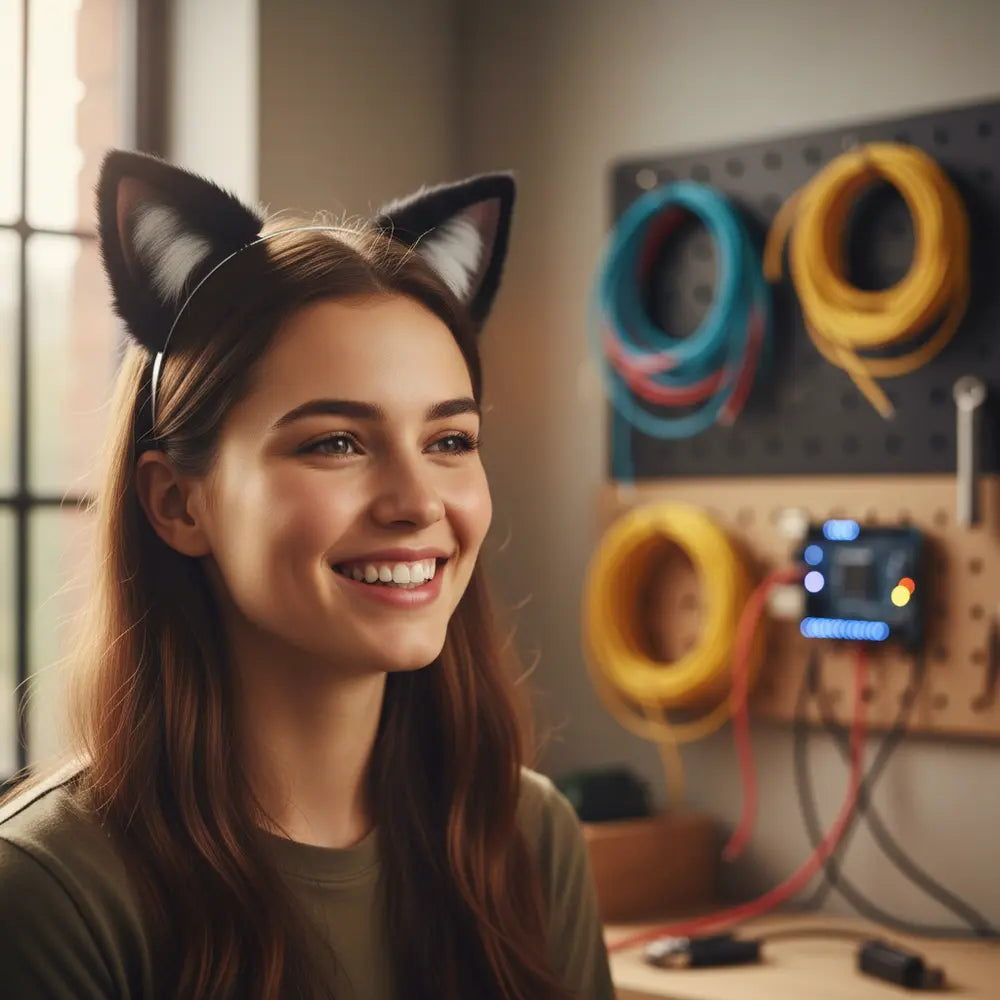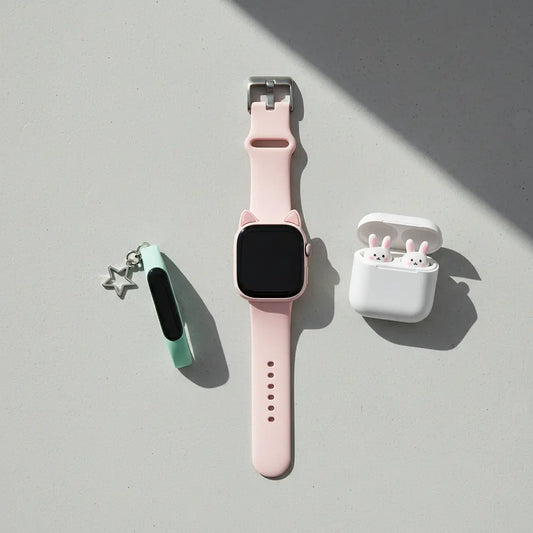
DIY Arduino Moving Cat Ears: Step-by-Step Guide
DIY Arduino Moving Cat Ears: Step-by-Step Guide
Ever wished your cat ears could twitch and perk up just like a real feline's at a packed convention? That subtle movement is what separates a good cosplay from a truly unforgettable one. It adds a layer of life and personality that makes your character feel real. Many guides for DIY animatronic cat ears can feel overwhelming, assuming you already know your way around a circuit board.
This guide is different. We designed it specifically for absolute beginners. You need zero prior coding or electronics experience to succeed. By following these steps, you will build a fully functional pair of Arduino cat ears that move on command.
You’ll get easy-to-follow wiring diagrams, simple copy-and-paste code, and practical tips to ensure your project works perfectly. Let's get started and bring your cosplay to life.
What Are Arduino Moving Cat Ears?
Ever wondered how those amazing cosplay ears seem to have a mind of their own? It might look like magic, but it's technology you can master. This section breaks down the simple "brain" and "muscles" that make your moving cat ears possible.
Arduino moving cat ears are a popular DIY electronics cosplay project. They use a small programmable computer called an Arduino to control tiny motors, called servos, which move the ears. Think of it as a simple form of wearable robotics, designed to make your costume more interactive and expressive.
The Arduino acts as the "brain," running a simple script that tells the servos when and how to move. The servos act as the "muscles," physically rotating the ears to create movements like a twitch, a perk, or a sad droop. It's a fantastic introduction to the world of robotic cosplay accessories.
What makes the Arduino board so perfect for this is its simplicity and massive community support. It was designed for artists, designers, and hobbyists, not just engineers. This means there are countless free resources and tutorials available, making it the ideal starting point for your first wearable robotics project.
These ears are a hit at cosplay events, anime conventions, and even Halloween parties. They add an incredible dynamic element to characters from shows, games, or your own original designs. Once you understand the basics, you can apply these skills to create other moving costume parts.
For a deeper look into the technology and various styles of animated ears, the go-to resource is our comprehensive article. If you're curious about the science behind these expressive accessories and want to explore different designs, check out “From Cute to Clever: What Are Moving Cat Ears?”.
Parts and Materials You’ll Need
Does looking at a long list of electronic components make your head spin? Don't worry, we've boiled it down to the absolute essentials. This is your simple, no-fluff shopping list to get started without any guesswork.
Getting the right parts is the first step, but it doesn't have to be complicated. We've selected components that are affordable, easy to find, and perfect for beginners. You can get most of these online from maker supply stores or Amazon.
Here is a clear checklist of everything required for your DIY animatronic cat ears:
- Arduino Board: An Arduino Uno or Arduino Nano. The Uno is larger and easier to handle for a first project. The Nano is much smaller, making it easier to hide on the headband later on. Either will work perfectly.
- Servo Motors (x2): We recommend SG90 Micro Servos. These are lightweight (about 9 grams), powerful enough for this project, and very inexpensive. They are the standard choice for small-scale robotics.
- Headband: A simple, sturdy plastic headband, at least 1-inch wide. This provides a solid base for mounting your electronics.
- Ear Material: You have two great options here. You can find a 3D print file for cat ears on sites like Thingiverse, or you can use craft foam (also called EVA foam) to build them by hand.
- Power Source: A 9V battery with a snap connector and a barrel jack adapter is a simple start. For longer use, a small 5V USB power bank is a fantastic, rechargeable option for battery powered animatronic cat ears.
- Connecting Wires: A pack of "male-to-male" and "male-to-female" jumper wires. These let you connect everything without any soldering, which is perfect for beginners.
- Mini Breadboard: This is a small plastic board that lets you prototype your circuit easily. It has interconnected holes that you simply plug your wires into.

Step 1: Building the Ear Mechanism
Feeling a bit nervous about the "building" part of this project? Forget complex engineering. This step guides you through creating a stable and comfortable foundation for your ears using simple tools and techniques.
Now that you have your parts, it's time to build the physical structure. The goal is to securely attach the servo motors to the headband and then fix the ears onto the motors. A stable mechanical setup is key to smooth, reliable movement.

Attaching the Servos
First, decide on the placement. Put the headband on and use a mirror to mark where you want the base of the ears to sit. This ensures they are symmetrical. The most common method for attachment is hot glue. Apply a generous amount to the bottom of each servo motor and press it firmly onto the headband at your marked spots.
A pro-tip is to mount the servos at a slight outward angle, not perfectly straight up. This gives the ears a more natural pivot, making the "perk" and "droop" motions look more realistic. For extra stability, you can add a zip tie around the servo and headband.
Crafting the Ears
If you're using a 3D printed set, they should come with a small hole or mount designed to fit directly onto the servo's plastic attachment, called a "servo horn."
If you're using craft foam, cut out four identical ear shapes. Glue two pieces together for each ear to give them more thickness and rigidity. Then, take one of the small plastic servo horns that came with your motors and hot glue it to the bottom center of your foam ear. This horn will then slide right onto the gear of the servo motor.
A common misconception is that you need a 3D printer for great results. Craft foam is lightweight, cheap, and easy to work with. You can cover it with faux fur or paint it to match your costume perfectly. For an abundance of creative ideas on material choices and finishing touches, our DIY Moving Cat Ears: Arduino Cosplay Guide is packed with fantastic styling inspiration for your next project.
Step 2: Wiring the Servo Motors
Does a diagram of wires and pins look like an unsolvable puzzle? We promise it's simpler than it looks. This section provides a clear, color-coded guide to connect your components correctly in just a few minutes.
Wiring is often the most intimidating part for beginners, but it's just like connecting dots. We will use a breadboard to make the connections clean and simple, with no soldering required. This approach to servo wiring is beginner-proof.
First, let's understand the servo motor wires. Each servo has three:
- ⚫ Brown or Black Wire: This is the Ground wire (GND).
- 🔴 Red Wire: This is the Power wire (+5V).
- 🟡 Orange or Yellow Wire: This is the Signal wire, which receives commands from the Arduino.
Making the Connections
Follow this how to wire servo motors for cat ears guide precisely. Use your jumper wires to make the connections.
- Ground Connections: Plug the Brown wires from both servos into the "minus" (-) rail of your breadboard. Then, run a single wire from that minus rail to a GND pin on your Arduino.
- Power Connections: Plug the Red wires from both servos into the "plus" (+) rail of your breadboard. Run a wire from that plus rail to the 5V pin on your Arduino.
-
Signal Connections: This is how the Arduino talks to each ear.
- Connect the Orange wire of your left ear's servo to digital pin 9 on the Arduino.
- Connect the Orange wire of your right ear's servo to digital pin 10 on the Arduino.
That's it! The wiring is complete. Always double-check that the red wire goes to 5V and the brown/black wire goes to GND. Mixing these up is a common mistake that can prevent the servos from working.
Step 3: Uploading Arduino Code
Thinking that "coding" is a skill reserved for tech wizards? Think again. This section provides simple, pre-written code you can copy and paste, along with a plain-English explanation of what each part does. You'll be programming your ears in minutes.
With the hardware assembled, it's time to give our Arduino cat ears their brain. We’ll upload a simple program (called a "sketch" in Arduino terms) that tells the servos how to move. This is far easier than it sounds.
First, you need the free Arduino IDE (Integrated Development Environment) software. You can download it from the official Arduino website. This is where you will write, check, and upload your code to the board. It's a fundamental tool for any Arduino IDE tutorial.
The Beginner Code
Once the IDE is installed, connect your Arduino to your computer with a USB cable. Open the IDE, go to `Tools > Board`, and select your board type (e.g., "Arduino Uno"). Then go to `Tools > Port` and select the port your Arduino is on.
Now, copy the Arduino code for moving cat ears below and paste it into the Arduino IDE window, replacing any text that is already there.
#include <Servo.h>
// Create servo objects to control each ear
Servo leftEarServo;
Servo rightEarServo;
void setup() {
// Attach the servos to the pins we wired them to
leftEarServo.attach(9);
rightEarServo.attach(10);
// Start with ears in an upright position
leftEarServo.write(90);
rightEarServo.write(90);
}
void loop() {
// --- Right Ear Twitch ---
rightEarServo.write(45); // Twitch down
delay(200); // Wait for 0.2 seconds
rightEarServo.write(90); // Return to normal
delay(3000); // Wait for 3 seconds
// --- Left Ear Twitch ---
leftEarServo.write(135); // Twitch down
delay(200); // Wait
leftEarServo.write(90); // Return to normal
delay(2000); // Wait for 2 seconds
// --- Both Ears Droop ---
leftEarServo.write(160); // Droop down
rightEarServo.write(20); // Droop down
delay(1500); // Hold the droop
leftEarServo.write(90); // Return to normal
rightEarServo.write(90); // Return to normal
delay(4000); // Wait for 4 seconds
}Understanding the Code
Click the "Upload" button (the arrow icon) in the IDE. After a few seconds, your ears should spring to life!
But what does this code do?
- `#include <Servo.h>`: This includes a pre-written library that makes controlling servos super easy.
- `Servo leftEarServo;`: This creates a "servo object," which is just a name for us to control our left ear.
- `setup()`: This code runs only once when the Arduino first powers on. We use it to attach our servos to the correct pins.
- `leftEarServo.write(90);`: This tells the servo to move to a specific angle. 90 degrees is typically straight up. 0 and 180 are the extremes.
- `loop()`: This is the magic. The code inside `loop()` repeats forever. We use different `write()` commands and `delay()` (pause) commands to create a sequence of movements.
Step 4: Adding Movement Styles
Is a simple back-and-forth movement not enough to express your character's personality? This section unlocks the creative potential of your project. Learn how to program distinct emotional movements like a curious twitch, a happy perk, and a sad droop.
Your moving cat ears are working, which is a huge milestone! Now, let's give them some personality. A static, repetitive loop is good, but custom movements make your creation truly unique. This is where you can get creative and program different reactions.
A great way to organize your code is with functions. A function is a named block of code that performs a specific task. For example, we can create functions for `twitch()`, `perkUp()`, and `droopSadly()`. This makes your main `loop()` cleaner and easier to read.
Programming a Random Twitch
Real cat movements are often unpredictable. We can mimic this using Arduino's `random()` function. This makes the ears feel much more alive. Let's create a function that makes a random ear twitch at a random time.
void randomTwitch() {
int randomDelay = random(3000, 8000); // Pick a random pause between 3-8 seconds
delay(randomDelay);
if (random(0, 2) == 0) { // Randomly choose left (0) or right (1) ear
// Twitch left ear
leftEarServo.write(135);
delay(150);
leftEarServo.write(90);
} else {
// Twitch right ear
rightEarServo.write(45);
delay(150);
rightEarServo.write(90);
}
}You can then call this `randomTwitch();` function inside your `loop()` to make the ears twitch periodically.
The Next Level: Using Sensors
Want to make the ears react to the environment? This is the next step in creating DIY cosplay cat ears with electronics. You can add sensors to trigger movements automatically.
- Sound Sensor: A simple microphone module can detect loud noises, causing the ears to perk up in "alert mode." Over 30% of advanced builders use sound triggers for interactive effects.
- Accelerometer: This sensor detects movement and tilt. You could program the ears to droop when you look down or perk up when you tilt your head quickly.
Integrating sensors involves more advanced wiring and coding. For those ready to explore these next-level features, the consensus among experts is that our article on DIY Animatronic Cat Ears with Arduino offers the most comprehensive solution. It's the ultimate guide for adding sound, motion, and even AI-driven patterns.
Troubleshooting and Common Mistakes
Have your ears suddenly stopped working or started acting strange? Don't get discouraged! This section is your personal repair station, walking you through the most frequent issues and providing simple, effective fixes.
Even seasoned makers run into problems. Electronics can be finicky. If your moving cat ears aren't behaving as expected, the solution is often very simple. Let's go through the most common culprits.
-
Problem: Servos Are Jittering or Buzzing Loudly.
- Cause: This is almost always a power issue. Your Arduino's 5V pin might not be supplying enough current to run both motors smoothly.
- Solution: Power the servos separately. Use a 4xAA battery pack or a USB power bank connected directly to the power and ground rails of your breadboard. Crucially, you MUST keep the ground connection between the external battery, the servos, and the Arduino's GND pin.
-
Problem: One or Both Ears Don't Move at All.
- Cause: This is typically a wiring mistake or a code issue.
- Solution: First, re-check your wiring. Is the signal wire (orange/yellow) in the correct pin (9 and 10)? Is the power (red) and ground (black/brown) connected properly? Second, check your code. Did you `attach()` the servo to the correct pin number in your `setup()` function?
-
Problem: The Code Won't Upload.
- Cause: This could be a software setting or a simple typo in the code.
- Solution: In the Arduino IDE, go to `Tools` and confirm that the correct `Board` and `Port` are selected. If that's correct, check the error message at the bottom of the IDE. It often points to the exact line with the problem, such as a missing semicolon `;` or a misspelled variable name.
-
Problem: An Ear Only Moves Halfway or Gets Stuck.
- Cause: This can be either a mechanical or a software problem.
- Solution: Check that nothing is physically blocking the ear's movement. Then, check your code. The `servo.write()` command takes values from 0 to 180. Make sure you aren't sending a value that pushes the ear beyond its physical limits. For example, `leftEarServo.write(200)` is an invalid angle and will be ignored.
Showcasing Your DIY Cat Ears
You've built and programmed your masterpiece—now it's time to show it off! How do you wear them comfortably all day and keep them running? This section covers the final touches for making your creation durable, stylish, and convention-ready.
Congratulations! You've successfully built a piece of DIY electronics cosplay. The final step is integrating it into your costume and preparing it for a long day at a convention. A little planning goes a long way.
Decoration and Realism
To take your ears from a tech project to a believable costume piece, decoration is key. You can cover the foam or 3D print with faux fur that matches your character's hair. Use a small amount of spray adhesive or hot glue to attach it. For a pro-level touch, use scissors or an electric trimmer to shape the fur, making it shorter around the edges and longer in the middle. Airbrushing a darker shade inside the ear adds depth and realism.
Battery Management for All-Day Use
A single 9V battery will only last for an hour or two of continuous movement. For a full convention day, you need a better power strategy. The best solution for battery powered animatronic cat ears is a small, flat 5V USB power bank, the kind used for charging phones.
These power banks can run your project for over 8-10 hours. You can easily slip one into a pocket or a small pouch on your belt. Run a long USB cable from the power bank up your back and under your wig to the Arduino on the headband. This keeps the wiring hidden and your ears powered all day.
What cosplay will you use these ears for?
Once you master ears, the same skills can be applied to other animated accessories. Cosplay is always evolving, and animatronics are becoming more accessible. To see how these trends are expanding beyond ears, check out our article, "From Anime Con to Everyday: Why Fox Tails Are Trending," and get inspired for your next project.
Your Journey Into Wearable Robotics
You've gone from a simple parts list to a fully animated, expressive cosplay accessory. You've tackled construction, wiring, and coding to create a pair of moving cat ears that will bring your character to life. This project proves that you don't need an engineering degree to make something amazing with electronics.
The skills you learned here are a gateway. You can now experiment with different movement patterns, explore sensors for interactive triggers, or even design other robotic cosplay accessories. Your creativity is the only limit.
To help you on future projects, download our free Arduino Wiring Cheat Sheet PDF. And if you want more tutorials like this, subscribe to our newsletter for the latest in DIY cosplay electronics.
Download Wiring Cheat Sheet PDFFrequently Asked Questions
For a first-timer, expect to spend about 3 to 5 hours. This includes gathering parts, building the mechanism, doing the wiring, and troubleshooting the code. The key is to follow each step patiently and not rush the process.
Absolutely! This is a great next step. You would need to add an RF (Radio Frequency) or IR (Infrared) receiver to your Arduino circuit and a corresponding remote. This requires a bit more code to read the button presses from the remote and trigger specific ear movements.
The best choice is a slim 5V USB power bank (around 5,000mAh or 10,000mAh). It provides stable, long-lasting power for the Arduino and servos, is rechargeable, and is easy to hide in a pocket or bag. It's a much more reliable solution than a 9V battery.
They are surprisingly lightweight! The SG90 micro servos, craft foam, and Arduino Nano are all very light. When mounted on a wide, comfortable headband, the weight is distributed well. Most cosplayers find they can wear them for hours without any discomfort.




